Minamisanriku: after the tsunami, Aussies helping Japanese heal
Aussie children’s theatre company Polyglot is part of the healing process in Japan’s tsunami-devastated Minamisanriku.
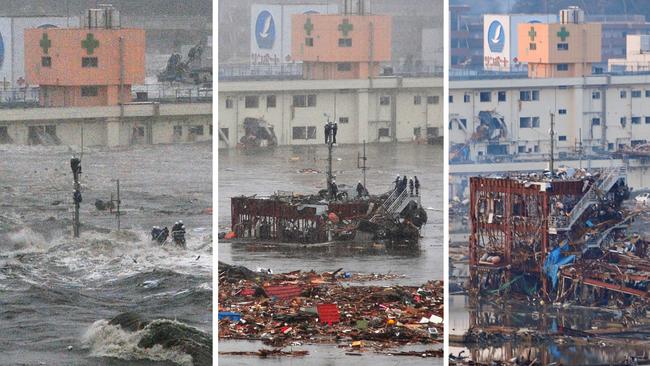
When he saw his house reduced to sticks and rubble as Japan’s 2011 tsunami devoured his town, Minamisanriku mayor Jin Sato was initially overwhelmed by a sense of unreality. “It was like something out of a movie,’’ he says. “I didn’t feel ‘Oh my God, my house!’ because every house was gone.’’
Sato and his municipal co-workers had climbed on to the roof of the three-storey disaster prevention centre in Minamisanriku as surging waves menaced the first and second floors. Even at this point, says the mayor, “nobody on the roof felt fear. They totally believed the tsunami would not come there.’’
But within minutes, the neighbouring city hall building that housed Sato’s office “divided in two and rammed this [disaster prevention] building’’. Only then did the municipal leader think, “Oh my God, this will be a disaster.’’
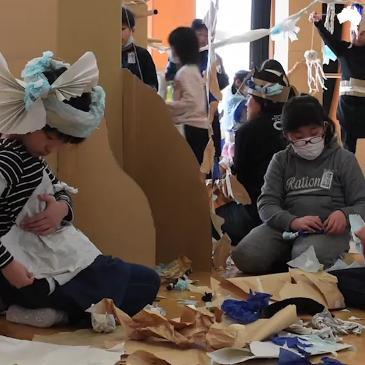
Last week, in a new council building erected — like the rest of the reconstructed town — on artificially elevated ground, Sato showed Review graphic images of the tsunami that pulverised the picturesque fishing village in northeast Japan, killing more than 800 of its residents.
One image, which has since become a potent symbol of humanity’s helplessness in the face of nature’s violence, shows 54 council workers, including Sato, on that flooded rooftop. Minutes later, a follow-up photograph was taken. “There are only 11 people in this one,’’ the mayor points out in a subdued tone.
In that brief time, 43 council workers had perished, swept away by the tsunami’s brown, broiling waters.
In the second rooftop image, which was reproduced around the world, two men cling to a 6m communications antenna, while a group that includes Sato huddles on a metal staircase as the wall of water threatens to overwhelm them.
“There was only a slight difference whether you lived or died,’’ Sato says, reflecting on the cruel arbitrariness of people’s fates after Japan was rocked by the biggest earthquake and tsunami in its history, and a related nuclear meltdown at Fukushima, almost 200km south of Minamisanriku. In all, the disaster claimed more than 18,500 lives.
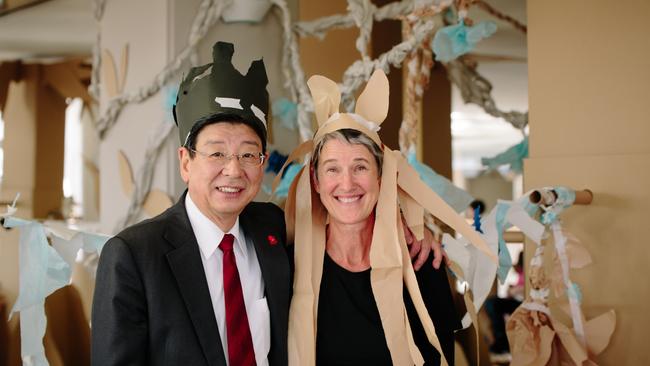
The tsunami’s seventh anniversary falls tomorrow, and in the emotive lead-up to it, Sato is speaking with Review and Australian theatre company Polyglot. The latter has worked closely with vulnerable residents in the town since 2011, when 70 per cent of its buildings were destroyed in minutes.
Sato, in his mid-60s, is an ebullient figure who is overseeing his home town’s extraordinary reconstruction — road by road, building by building, it is being elevated by 6m. Yet this local politician, who has been diagnosed with post-traumatic stress disorder, also has about him a subtly wounded air.
Polyglot, an award-winning interactive children’s theatre company, has worked on four projects in Minamisanriku, with the mayor’s backing. Sue Giles, the company’s artistic director, says this work can be “emotionally confronting, but seeing up close the optimism and courtesy that happens in this town has been an extraordinary privilege’’.
Polyglot’s long-term investment in the once-stricken town is part of a wider recovery strategy in which Australia unofficially “adopted” the town. The mayor says he is grateful for Australia’s commitment, with everyone from rescue workers — deployed to the fishing village in the desolate days following the tsunami — through to diplomats, former prime minister Julia Gillard, big business and Polyglot helping the townspeople find their way back from near-annihilation.
In fact, Gillard’s 2011 visit is almost the first thing the mayor mentions to Review. “Julia Gillard was the first (foreign) prime minister to visit here,’’ he says approvingly. A visibly moved Gillard and Sato posed for media photographs in the flattened town centre. “I have that picture on the wall of my home,’’ he says.
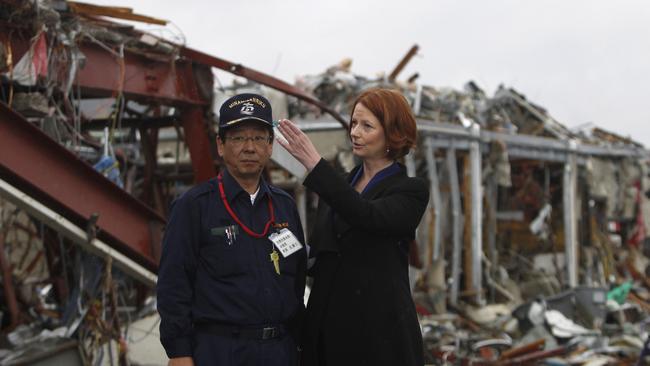
Seven years on, the fishing village — the centre of which is a vast construction zone dominated by heavy machinery and huge pyramids of soil — “is still in recovery mode”, says Giles. “The adults talk about the lack of places for children to play — it’s a big thing. They talk about the need to instil hope and for the children to feel there is a future for them.’’
Education authorities say a third of Minamisanriku’s students have moved away since 2011. “Another reason they have welcomed us back so enthusiastically,’’ says Giles, “is that they feel that people have forgotten [what they went through].’’
Polyglot returned this week, staging its acclaimed interactive installation and music-theatre piece Paper Planet in the town and at five primary schools. Giles calls the show “an artistic response to a town that has had its environment ripped away’’.
The installation, which has toured extensively in Australia and overseas, is an ingenious cardboard forest, complete with an elegant Shinto gate in the Japanese iteration. Children are encouraged to role play and make their own sculptures from paper or cardboard, while adult performers, dressed in homemade cardboard and tissue-paper costumes, play music or become improvised characters within the forest.
Giles says that while Paper Planet doesn’t address the tsunami directly, it alludes to the importance of the environment in a disaster-hit town that is now “unrecognisable’’, compared to the quaint, traditional fishing village — famous for its octopus and onsen (hot springs) — that existed before the tsunami.
To the adult eye Paper Planet can seem unformed and random — but that’s the point, it’s about drawing out the children’s creativity and sense of agency. “Japanese society is highly structured, but in our shows children make the choices,’’ says Giles.
At the first performance I see, the children, mostly girls, initially seem shy and hesitant, but by the end they are trying to mummify performer Mischa Long with sticky tape, while Japanese musicians perform and dance to an improvised soundtrack.
The company’s first involvement with the town was a puppetry project conducted several months after what is now called the Great East Japan Earthquake. Company member Stephanie Robinson says she and other Australians arrived to see towers of wrecked cars in the streets and debris two storeys high lining the bay. Today, fishermen in slender one and two-man boats calmly tend to the long, thin nets that cover this broad, beautiful bay, as fishermen have done here for centuries.
In the months following the tsunami, thousands of townspeople who had lost loved ones and homes were living in schools, gyms and shipping containers; by 2013, many residents were still confined to the containers. In that year, Polyglot, which has worked with traumatised communities in Australia, brought its acclaimed children’s show We Built This Town to Minamisanriku.
In this installation, students who had seen their homes and neighbourhoods obliterated created their ideal town from thousands of cardboard boxes; many of them erected intricately detailed shops, reflecting how their own village had lost this important community hub.
The third project, in 2015, involved the production of a comic book in English and Japanese. Giles says the focus was on encouraging kids to retell the stories of their community’s elders, many of whom had selflessly insisted that younger generations should take the new houses first.
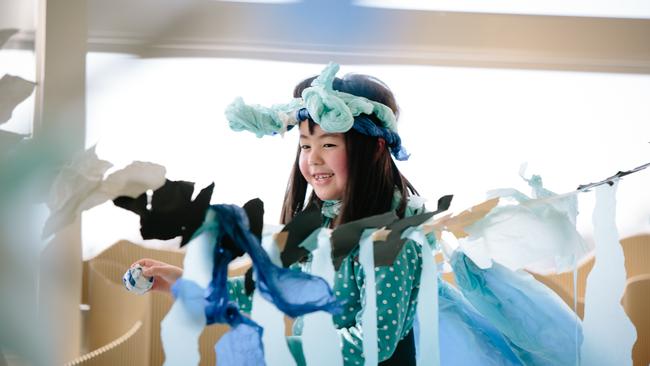
Arts projects may seem a soft response to a crisis of this scale, but Giles believes “creativity is important when you’re trying to rebuild a whole town’’. Polyglot’s local collaborator, Japanese music-drama company Acchi Cocchi, agrees. Mikako Atsuchi, the company’s president, started organising informal cafe concerts of classical music, Japanese folk songs and children’s songs in Minamisanriku four months after the disaster, because “people needed music and culture to heal their injured hearts’’.
For her first round of concerts, she made cake for 300 people and drove it eight hours to the fishing village from her company’s base in Yokohama. “I found out the most important thing is to bring something fun, something happy, something positive,’’ she says.
Through Acchi Cocchi’s collaboration with Polyglot, Atsuchi says, “I have discovered another way to attract children. There is a big border separating the adult and childhood worlds in Japanese culture.’’ But Polyglot’s works often led to children seamlessly building on adults’ work and ideas, and vice versa.
One of Australia’s most enduring children’s theatre companies, Polyglot has been invited to the town’s memorial service tomorrow. Giles says she has seen many local people “working strongly together to make positive outcomes for everybody’’. Yet Robinson — the sole company member to have taken part in all four projects — reveals that as recently as 2015, she feared the town might not bounce back; “that it had reached a point of no return’’.
Three years on, she is astonished by the progress. Most of the town’s residents now have new homes, and a shopping precinct and hospital have been built — all located well away from the bay and the rivers that course through the town. In a sense, with its steep, concreted river banks and mountains of transplanted earth, the town has taken up a defensive posture against the same force of nature — the ocean — that sustained it for centuries.
■ ■ ■
There is a widely held belief communities and individuals instinctively pull together in times of adversity and loss — and Polyglot has seen clear evidence of this. However, the narrative of grief is not always so clear, or clean. Mayor Sato emerged in the years following the catastrophe as a hero to many, and a questionable leader to some. On the one hand, he is an amazingly stoic figure: a tsunami survivor who saw his colleagues die, yet has stayed at his post, continuing to drive the reconstruction of his home town. On the other hand, he has been accused of professional negligence — which he firmly denies — by families whose relatives died in the disaster prevention building. Among other complaints, the families said the building should have been located on higher ground.
But the mayor says the first official warnings said the tsunami would be 6m high. “Instead, it was 12m high,’’ he tells Review. “Nobody believed the tsunami would come to this level. It was the biggest earthquake the Japanese have ever experienced.’’
In the devastated town, there was fierce debate over whether the distinctive red skeleton of the disaster prevention building should be demolished — in the end, it was preserved as a symbol of what the town has endured. The town’s heroine, a young woman called Miki Endo, worked in that building. On the day of the disaster, Endo remained at her desk until the last minute, using loudspeakers to warn people to get to higher ground and escape the waves that claimed her life.
When Review visits the building — now dwarfed by the excavators, trucks and those soil mountains being used to raise the town — Japanese women cry openly. Nearby is an improvised community shrine, with statues of Buddha, flowers and colourful strips of origami serving as tributes to those who died here. The mayor says that “for three or four years, it was too painful’’ to talk about his personal experience of the tsunami. But now he feels he has a duty to tell the story.
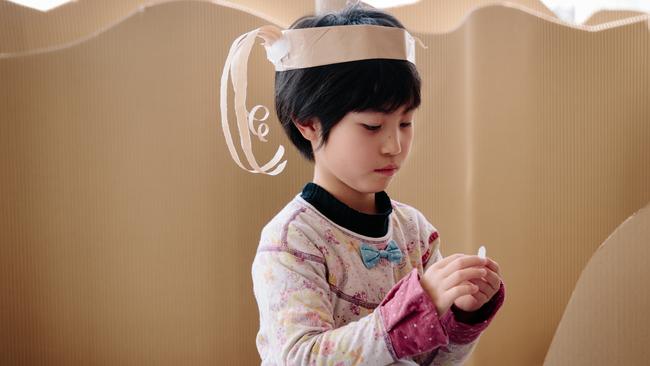
In the days after the disaster, “I couldn’t imagine how the town could be rebuilt,” he says. “But I am so proud of being here now. The history of this town is a history of tsunamis. Tsunamis will happen again, so my goal is to remake the streets so that people don’t lose their lives.’’
He has twice lost family homes to tsunamis — once in 1960, when he was a boy, and again in 2011. By rebuilding houses on higher ground, “people can be home and feel safe; they do not have to worry about escaping’’.
Polyglot’s projects also promote a sense of security and normalcy among the town’s youngest residents. Tatsuro Sato, chairman of Minamisanriku’s board of education, says the company’s interactive projects have helped tsunami-hit towns recover because they are “fun, and for many students it’s their first chance to join in this kind of experience”. But he adds that in the case of older pupils, “supporting their mental health is the biggest challenge. Some of them are not stable, even now.’’
He is “very impressed” with the concern Australians have shown towards Minamisanriku, so many of whose children lost parents, siblings, grandparents or neighbours. “The connection between Australia and Japan became deeper and deeper after the earthquake,’’ he says. He also finds it “amazing” that students from the town have been invited into Australians’ homes through a homestay program.
One consolation is that only three school students from Minamisanriku — where most of the schools were built away from the coast — were killed in the tsunami.
Okawa elementary school, a 30-minute drive away, was not so lucky. School officials at this campus stopped primary school children from escaping the coming waves by climbing an adjacent hill. The school lacked a coherent evacuation plan and, as a result, 74 students and 10 teachers, most of the school’s population, died. This poignant loss of life became notorious throughout Japan and the bereaved parents successfully sued education authorities.
Another regional school, Natari elementary school, was flooded during the tsunami, but no lives were lost. Although it is just metres from a small, rugged beach, the community decided to keep the campus in its current location.
Education authorities have moved all classrooms to the second floor and upgraded exits to the hill behind. Polyglot takes Paper Planet to this school, where year one students, mostly boys, arrive wearing identical face masks but prove to be an exuberant bunch. They have a liking for paper samurai swords that they wield with gusto on each other, the installation and Polyglot’s performers — thus smashing the stereotype of the passive, near-silent Japanese student.
Giles admits that when it comes to disaster recovery, “as an artist you go in thinking: ‘Am I really helping here?’ But the responses we’ve been getting through these four years have been really encouraging.
“We have made a difference.’’
Mayor Sato, meanwhile, decided during his terrifying rooftop ordeal that rebuilding his home town would be his defining mission. “That was the only thing I could do,’’ he has said, “for my lost companions.’’
Rosemary Neill travelled to Japan with the assistance of Polyglot theatre company.

